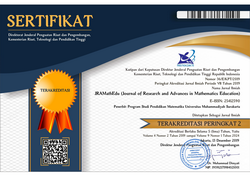Geometry Concept on the Motifs of Woven Fabric in Kefamenanu Community
Yohanis Ndapa Deda(1*), Stanislaus Amsikan(2)(1) Department of Mathematics Education, Universitas Timor
(2) Department of Mathematics Education, Universitas Timor
(*) Corresponding Author
Abstract
Keywords
Full Text:
PDFReferences
Abi, A. M. (2016). Integrasi etnomatematika dalam kurikulum matematika sekolah. JPMI
Jurnal Pendidikan Matematika Indonesia,1(1),1-6). Singkawang: STKIP Singkawang.
Amsikan, S., &Nahak, S. (2017). Hubungan konsep Ruang Ume Kbubu Desa Kaenbaun
Kabupaten Timor Tengah Utara dengan konsep geometri. Prosiding KNPM II, 2017,pp.168-175. Surakarta: UMS Surakarta.
Arwanto, (2017). Eksplorasi etnomatematika Batik Trusmi Cirebon untuk mengungkap
nilai filosofi dan konsep matematis. Phenomenon Jurnal Pendidikan MIPA, 7(1), 4049). Semarang: State Islamic University Walisongo.
Deda, Y. N., & Disnawati, H. (2017). Hubungan motif kain tenun masyarakat Suku Dawan – Timor dengan matematika sekolah. Prosiding KNPM II, 2017, pp.201209. Surakarta: UMS Surakarta.
Denzin, N.K., & Lincoln, Y.S. (Eds.). (2011). Handbook of qualitative research fourth edition. California: Sage Publication.
Dominikus, W.S., Nusasantara, T., Subanji, & Muksar, M. (2017). Ethnomathematical Ideas in the Weaving Practice of Adonara Society. Journal of Mathematics and Culture, 11(4), 83-95. USA: JMC.
Greer, B. (2009). Culturally responsive mathematics education. Oxford: Routledge Taylor and Francir Group.
Helsa,Y. & Hartono,Y. (2014). Designing reflection and symetry by using math traditional dance in primary school. Journal on Mathematics Education (IndoMS-JME), 2(1), 79-94. Palembang: IndoMS.
La’a, A. S. & Suwartiningsih, S. (2013). Makna tenun ikat bagi perempuan. KRITIS Jurnal Studi Pembangunan Interdisiplin, 22(1), 21-40. Salatiga: Perpustakaan Daerah Kota Salatiga.
Lela, L. (2002). Katalog Tenunan Kabupaten Timor Tengah Utara. Kefamenanu: Dewan Kerajinan Nasional Daerah Timor Tengah Utara.
Muhtadi, D., Sukirwan, Warsito, & Prahmana, R., C., I. (2017). Sundanese ethnomathematics: mathematical activities in estimating, measuring, and making patterns. Journal on Mathematics Education (IndoMS-JME), 8(2), 185-198. Palembang: IndoMS.
Putri, L., I. (2017). Eksplorasi etnomatematika kesenian rebana sebagai sumber belajar matematika pada jenjang MI. Jurnal Ilmiah PENDIDIKAN DASAR, 4(1), 21-31. Bali: Undiksha.
Risdiyanti, I., & Prahmana, R. C. I. (2017). Ethnomathematics: Exploration in javanese culture. AD INTERCOMME IOP Publishing IOP Conf. Series: Journal of Physics: Conf. Series 2017. Ahmad Dahlan University.
Rosa, M. & Orey, D.C. (2011). Ethnomathematics: the cultural aspects of mathematics. Revista Latino Americana de Etnomatematica, 4(2), 32-54. Colombia: Sistema de Información Científica.
Sabilirrosyad, (2016). Ethnomatics Sasak: Eksplorasi geometri tenun suku Sasak Surakarta dan implikasinya untuk pembelajaran. JURNAL TATSQIF Jurnal Pemikiran dan Penelitian Pendidikan, 4(1), 49-65. Mataram: IAIN Mataram.
Snipes, V. & Moses, P. (2001). Linking mathematics and culture to teach geometry concepts. LTM Journal Louisiana Association of Teacher of Mathematics. Retrieved www.lamath.org/journal/Vol1/LinkCult
Spradley, & James, P. (2006). Metode Etnografi. Yogyakarta: Tiara Wacana.
Turmudi. (2017). Kajian Etnomatematika: belajar matematika dengan Melibatkan Unsur Budaya. Prosiding Seminar Nasional Etnomatnesia 2017, 38-53. Yogyakarta: Universitas Sarjanawiyata Tamansiswa.
Ulum, B., Budiarto, M. T., & Ekawati, R. (2017). Etnomatematika Pasuruan: Eksplorasi Geometri Untuk Sekolah Dasar Pada Motif Batik Pasedahan Suropati. Prosiding SIMaNIs (Seminar Nasional Integrasi Matematika dan Nilai Islami) 2017, 70-78. Malang: UIN Maulana Malik Ibrahim Malang.
Article Metrics
Abstract view(s): 1239 time(s)PDF: 925 time(s)
Refbacks
- There are currently no refbacks.








